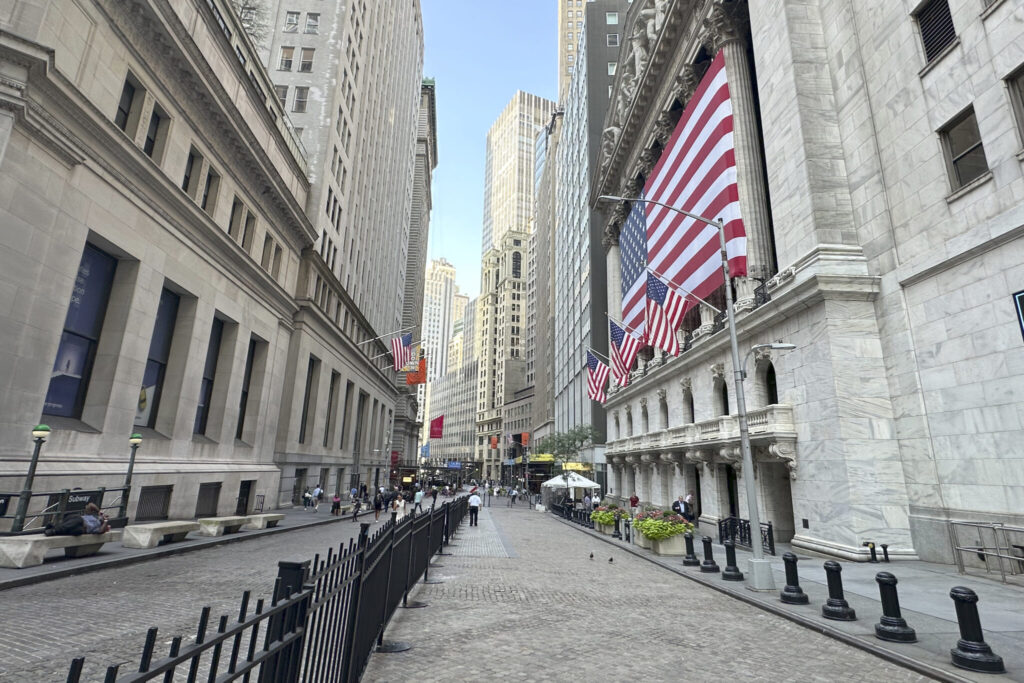U.S. stocks are slipping on Friday, as businesses around the world scramble to contain the effects of a disruptive technology outage. The S&P 500 was 0.4% lower in midday trading, a day after a widespread wipeout dragged down much of the market, and it’s on track to close its worst week in months. The Dow Jones Industrial Average was down 366 points, or 0.9%, and the Nasdaq composite was 0.4% lower.
Quick Read
- Wall Street Declines Amid Disruptions:
- Market Performance: U.S. stocks are falling, with the S&P 500 on track for its worst week since April. The Dow Jones Industrial Average dropped 0.9%, while the Nasdaq composite fell 0.4%.
- Technology Outage Impact: A major global technology outage, attributed to a faulty update from CrowdStrike, disrupted flights, banks, and other services. CrowdStrike’s stock initially fell 15% but later recovered slightly. Microsoft also saw a minor decline.
- Corporate Earnings: Companies reported mixed results. Comerica’s stock fell 12.4% despite beating earnings expectations due to a loss of a significant contract. American Express dropped 4.2% after revenue missed forecasts. In contrast, Huntington Bancshares rose 2.7% on better-than-expected profit, and Netflix fluctuated but was up 0.4% after reporting stronger profit.
- Sector Movements: Halliburton’s shares fell 5% after missing revenue expectations, while SLB’s shares rose 3.3% due to strong profit. The Russell 2000 index of smaller stocks is also down, following a previous surge.
- Broader Economic Indicators: The 10-year Treasury yield rose slightly to 4.23%. Global markets showed mixed performance, with European and Asian indexes largely lower, although Shanghai saw a modest gain after a major Chinese policy briefing.
The Associated Press has the story:
Wall Street slips as S&P 500 heads for its worst week since April
Newslooks- NEW YORK (AP) —
U.S. stocks are slipping on Friday, as businesses around the world scramble to contain the effects of a disruptive technology outage. The S&P 500 was 0.4% lower in midday trading, a day after a widespread wipeout dragged down much of the market, and it’s on track to close its worst week in months. The Dow Jones Industrial Average was down 366 points, or 0.9%, and the Nasdaq composite was 0.4% lower.
The relatively calm trading came as a major outage disrupted flights, banks and even doctors’ appointments around the world. Cybersecurity firm CrowdStrike said the issue believed to be behind the outage was not a security incident or cyberattack and that it had deployed a fix. The company said the problem lay in a faulty update sent to computers running Microsoft Windows.
CrowdStrike’s stock immediately plunged more than 15% when the market opened for trading, but it then nearly halved that to a loss of 8.4%. Microsoft was down 0.4%. Richard Stiennon, a cybersecurity industry analyst, called it a historic mistake by CrowdStrike, but he also said he did not think it revealed a bigger problem with the cybersecurity industry or with CrowdStrike as a company.
“We all realize you can fat finger something, mistype something, you know whatever — we don’t know the technical details yet of how it caused the bluescreen of death” for users, he said. “The markets are going to forgive them, the customers are going to forgive them, and this will blow over.”
Long lines of frustrated fliers formed at airports around the world as the outage hit check-in procedures, which initially helped pull down U.S. airline stocks. But they quickly pared their losses, and United Airlines flipped to a gain of 0.1%. It said many travelers may experience delays, and it issued a waiver to make it easier to change travel plans.
American Airlines Group slipped 0.6%, and Delta Air Lines dipped 0.5%. Corporate profit reports were also moving stock prices, and Comerica dropped 12.4% even though it delivered better earnings for the spring than analysts expected. The bank said it received a preliminary notification that it won’t continue as the issuer of the Direct Express debit card for about 4.5 million federal benefit recipients, a program it’s had since 2008.
American Express sank 4.2% after its revenue for the latest quarter fell short of analysts’ forecasts. It was one of the largest reasons for the Dow’s drop, despite reporting stronger profit than expected. On the winning side of Wall Street was Huntington Bancshares. It rose 2.7% after reporting better profit for the latest quarter than expected. It delivered growth in various forms of profit as its total deposits increased.
Netflix was flipping between gains and losses after the streaming giant reported stronger profit for the latest quarter than analysts expected. It was most recently up 0.4%. Halliburton fell 5% after the provider of services to the energy industry matched analysts’ expectations for profit last quarter but missed for revenue. Its rival, SLB, added 3.3% after its profit topped expectations.
The broad S&P 500 index is on track for its worst week since April, even though it set an all-time high on Tuesday. At first, pressure built on the Big Tech stocks that have been the market’s biggest winners, amid criticism they simply grew too expensive. Nvidia, for example, is up more than 140% for the year so far amid Wall Street’s frenzy around artificial-intelligence technology.
Such declines pack a punch on the S&P 500 because it gives more weight to stocks with larger values, and Big Tech companies are by far Wall Street’s most massive. Gains for some previously unloved areas of the market, including smaller stocks and companies whose profits are closely tied to the economy’s strength, had helped to offset some of those declines.
“This rotation can continue, but it doesn’t always have to be where they’re rising faster, it could be because they are falling less,” according to Brian Jacobsen, chief economist at Annex Wealth Management. “The eventual improvement in fundamentals of small and value could help cushion the downside and provide great long-term opportunities.”
On Thursday, Wall Street saw a washout that pulled down most stocks across the market, including beaten-down smaller companies and what are called “value” stocks. The Russell 2000 index of smaller stocks was on track for a third straight drop on Friday after slipped another 0.6%. That follows a huge five-day run where it shot up 11.5%. The index had a brief issue Friday morning, where “a third party technical issue” prevented clients from getting real-time data on it.
Besides the surges for Big Tech stocks, hopes for coming cuts to interest rates by the Federal Reserve have also buoyed the U.S. stock market and sent Treasury yields lower. Yields were ticking higher in the bond market on Friday. The yield on the 10-year Treasury rose to 4.23% from 4.20% was late Thursday.
In stock markets abroad, indexes were mostly lower in Europe and Asia. Stock indexes fell 2% in Hong Kong and rose 0.2% in Shanghai after Chinese officials briefed reporters in Beijing on the outcome of a top-level meeting of the ruling Communist Party. They provided some details of the sweeping blueprint it endorsed for making China a leader in technology, building its financial markets and raising living standards.







